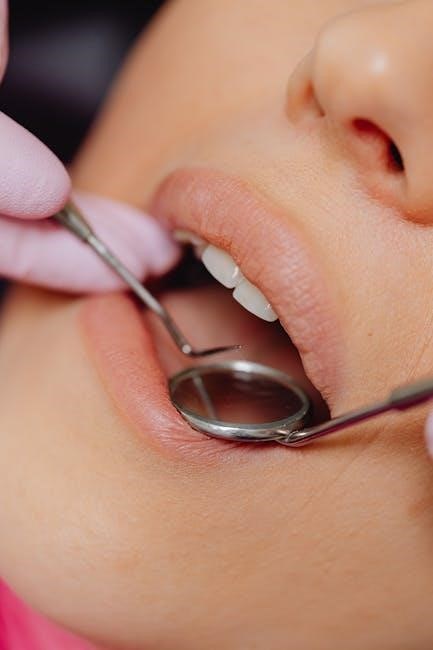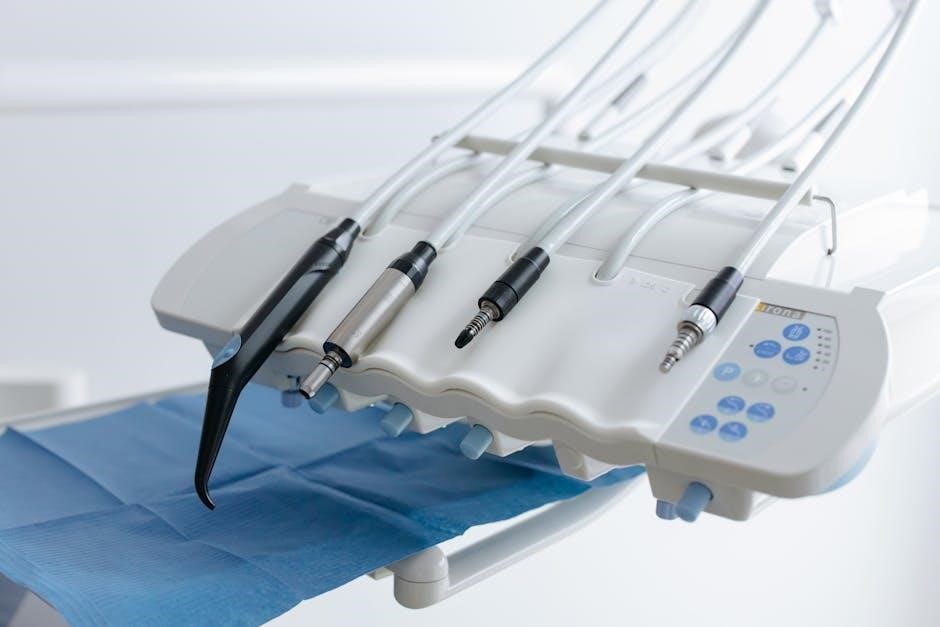types of dental burs and their uses pdf
Dental burs are essential tools used in dentistry for various procedures, including cutting and polishing tooth structures, with different types available for specific uses and applications in dental treatments always.
Definition and Classification of Dental Burs
Dental burs are defined as rotary instruments used in dentistry to cut, grind, and polish tooth structures, with various classifications based on their shape, size, and material.
The classification of dental burs is crucial for selecting the right tool for specific dental procedures, and it involves categorizing them into different types, such as carbide and diamond burs.
The definition and classification of dental burs are essential for understanding their uses and applications in dentistry, and for ensuring that the right bur is used for each procedure.
Dental burs can be classified based on their shank type, head shape, and size, with each type designed for specific uses, such as cutting, grinding, or polishing.
The classification of dental burs also involves considering the material they are made of, with different materials offering varying levels of durability and effectiveness.
Overall, the definition and classification of dental burs are critical components of dentistry, and are essential for providing effective and efficient dental care.
The different classifications of dental burs are used to determine the best tool for each specific procedure, and to ensure that the highest level of care is provided to patients.
By understanding the definition and classification of dental burs, dentists can make informed decisions about which tools to use, and can provide the best possible care for their patients.
The classification of dental burs is a complex and multifaceted process, and requires a thorough understanding of the different types of burs and their uses.
Dental burs are an essential part of dentistry, and their definition and classification are critical components of providing effective care.
The different types of dental burs are designed to meet the specific needs of patients, and are used to provide a range of dental procedures, from routine cleanings to complex surgeries.
By understanding the definition and classification of dental burs, dentists can provide the highest level of care, and can help patients achieve optimal oral health.

Types of Dental Burs
Dental burs come in various shapes and sizes, including round, fissure, and tapering types, each designed for specific dental procedures and applications always used.
Carbide and Diamond Burs
Carbide and diamond burs are two types of dental burs commonly used in dentistry, with carbide burs being more durable and resistant to wear, and diamond burs being more effective for cutting and grinding hard tooth structures.
These burs are made from high-quality materials and are designed to provide efficient and precise cutting and grinding actions, making them essential tools for dental professionals.
The unique properties of carbide and diamond burs make them suitable for various dental procedures, including cavity preparation, crown preparation, and enamel shaping, and they are available in different shapes and sizes to suit specific needs.
Overall, carbide and diamond burs are important components of a dental professional’s toolkit, and their effective use can help to achieve high-quality results in a variety of dental procedures, with proper care and maintenance being essential to extend their lifespan and ensure optimal performance always.
Design and Modifications of Dental Burs
Dental burs have unique designs and modifications for specific uses always with different shapes and sizes available.
Shank Types and Materials
Dental burs have different shank types, including straight and friction grip shanks, which are made from various materials, such as stainless steel, titanium, and tungsten carbide, each offering unique properties and advantages. The choice of shank type and material depends on the specific application and procedure, as well as the dentist’s personal preference. Some shanks are designed for high-speed drilling, while others are suitable for low-speed procedures. The material used for the shank can also affect the bur’s durability and resistance to wear and tear. Furthermore, the shank’s design and material can influence the bur’s overall performance and efficiency in removing tooth structure. The various shank types and materials available allow dentists to select the most suitable bur for their specific needs and procedures, ensuring optimal results and patient satisfaction, with proper care and maintenance also being essential.

Uses of Dental Burs in Dentistry
Dental burs are used for cutting, grinding, and polishing tooth structures in various dental procedures always effectively.
Cutting, Grinding, and Polishing Tooth Structures
Dental burs are used for various dental procedures, including cutting, grinding, and polishing tooth structures. The choice of bur depends on the specific procedure and the type of tooth structure being worked on. Different types of burs are designed for specific tasks, such as removing decay, shaping teeth, and smoothing surfaces. The bur’s shape, size, and material determine its effectiveness in cutting, grinding, and polishing tooth structures. Dental burs are an essential tool in dentistry, allowing for precise and efficient removal of tooth material. They are used in a variety of procedures, from routine cleanings to complex restorations. The ability to cut, grind, and polish tooth structures with precision is crucial in achieving successful dental treatments. Dental burs play a critical role in this process, enabling dentists to provide high-quality care to their patients; Overall, dental burs are a vital instrument in dentistry.

Selection of Dental Burs for Specific Procedures
Proper dental bur selection is crucial for successful procedures and outcomes always requiring careful consideration of factors.
Factors Influencing Bur Cutting Efficiency
Dental bur cutting efficiency is influenced by several factors including the type of bur, its material, and the speed at which it is used. The design and shape of the bur also play a crucial role in determining its cutting efficiency. Additionally, the condition of the bur, whether it is new or worn out, can significantly affect its performance. The hardness of the tooth structure being cut is another important factor that can impact bur cutting efficiency. Furthermore, the use of coolants or lubricants can also influence the cutting efficiency of dental burs. Overall, understanding these factors is essential for selecting the right bur for a specific procedure and ensuring optimal cutting efficiency. By considering these factors, dentists can choose the most suitable bur for their needs and achieve the best possible results. This is important for successful dental procedures.

Care and Maintenance of Dental Burs
Proper cleaning and storage of dental burs is necessary always to maintain their effectiveness and extend lifespan of dental instruments used.
Importance of Proper Care for Bur Longevity
The importance of proper care for dental bur longevity cannot be overstated, as it directly impacts their performance and lifespan. Regular cleaning and maintenance are essential to prevent damage and corrosion. Proper storage in a dry and clean environment also helps to extend the life of dental burs. Additionally, following the manufacturer’s instructions for use and maintenance can help to prevent premature wear and tear. By taking these simple steps, dental professionals can help to ensure that their dental burs remain effective and last longer, reducing the need for frequent replacements and saving time and money in the long run. Effective care and maintenance routines can also help to prevent cross-contamination and ensure patient safety, making them a crucial part of any dental practice. Proper care is essential for bur longevity and overall dental practice success.


